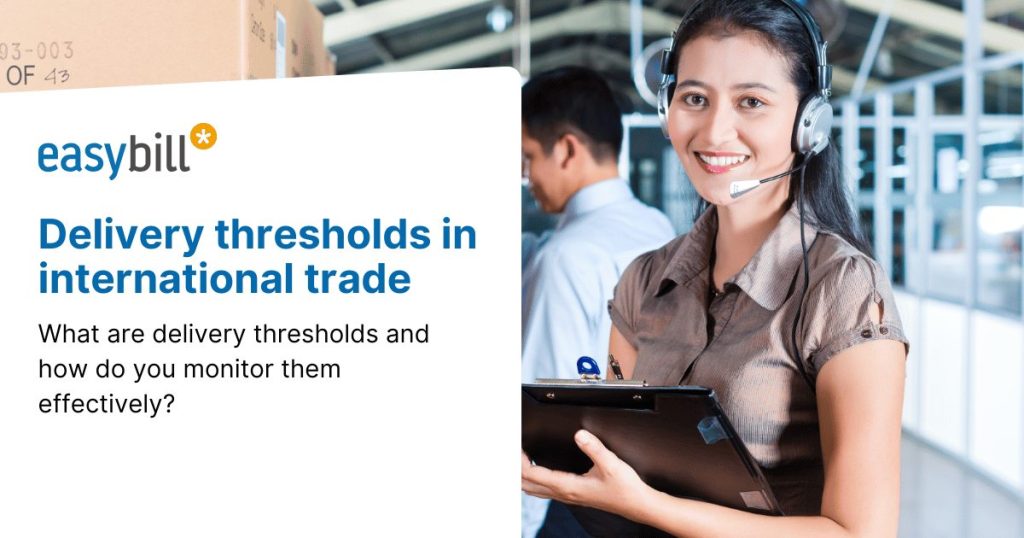
In international trade, companies face various challenges, especially when it comes to the cross-border movement of goods. One of these challenges is monitoring delivery thresholds. Companies that operate internationally need to keep a close eye on delivery threshold regulations in order to avoid unpleasant surprises, such as unexpected tax obligations.
Read more about delivery thresholds and how you can automate delivery threshold monitoring with easybill in our blog.
What are delivery thresholds?
Delivery thresholds are turnover limits that determine when you as an entrepreneur become liable for VAT in another country. These regulations generally apply to cross-border B2C trade, i.e. sales to private individuals in other countries. If the turnover exceeds the defined delivery threshold of a country, you are obliged to pay VAT in that country.
E-commerce and delivery thresholds
Delivery thresholds play a particularly important role in the e-commerce sector, which has seen explosive growth in recent years. If you sell in several countries within the EU or worldwide, you must monitor the respective sales thresholds of each individual country.
Since July 1, 2021, there has been a new regulation for e-commerce and companies in the EU: the OSS (One-Stop-Shop). This simplifies the registration and payment of VAT for companies that sell to several EU countries. Nevertheless, the monitoring of delivery thresholds in the EU remains an important issue. As soon as your sales exceed the uniform delivery threshold of EUR 10,000 per year, you must pay VAT in the respective country of destination.
Why is the monitoring of delivery thresholds in international trade so important?
Monitoring delivery thresholds in international trade is crucial for any company that regularly delivers abroad. By complying with the delivery thresholds, you can avoid having to pay VAT retrospectively. This can not only be expensive, but can also lead to administrative costs and legal problems. In e-commerce in particular, it is often difficult to maintain an overview, as sales can increase quickly and unexpectedly.
International differences in the delivery threshold regulation
International delivery thresholds and VAT vary considerably from country to country. Within the EU, the regulations are now somewhat standardized, but in third countries such as the USA or Australia, there are completely different thresholds and regulations. In the USA, for example, the individual states have their own sales thresholds. This means that you need to keep a close eye on the delivery threshold regulations in each country or state in order to meet your tax obligations on time.
More about delivery threshold monitoring in easybill
easybill tracks sales to other EU countries automatically. How does it work?
Tips for monitoring delivery thresholds
- Using automated tools: There are now numerous software solutions that can help you monitor delivery thresholds. These tools are particularly useful in e-commerce to automatically calculate when and in which country a delivery threshold is exceeded.
easybill’s Import Manager monitors this delivery threshold for EU sales and informs you in good time that you should inform yourself about the One-Stop-Shop and register. - Regular review: You should regularly analyze your sales, especially if you are expanding into new markets. Delivery thresholds can change from year to year and it is important to keep up to date.
- Advice from tax experts: As the supply threshold regulations for cross-border trade can be very complex, it is advisable to seek regular advice from a tax advisor or international trade expert. This will ensure that you always act in accordance with the applicable regulations.
Keep an eye on delivery thresholds and avoid penalties
Monitoring delivery thresholds in international trade is a must for every company that operates across borders. Especially in e-commerce, unexpected surges in sales can quickly lead to you triggering tax obligations in different countries. However, with the right strategy, the use of automated tools and the support of experts, you can ensure that you always remain compliant and can expand your business internationally without unexpected tax burdens.
It is worth taking a close look at the various regulations and regularly monitoring developments in the respective countries.
Read also:
ZUGFeRD – der neue Standard für die europäische E-Rechnung
Korrekturfall: Lieferschwelle nicht rechtzeitig aktiviert
Mehrwertsteuer in der Gastronomie: Erfolgsstrategien für Betriebe

